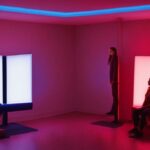Last Updated on 12 months by Francis
Light therapy is a non-invasive treatment that uses specific wavelengths of light to improve mood, sleep, and skin health. It has been used for decades to treat various medical conditions, including seasonal affective disorder (SAD), depression, and sleep disorders. In this article, we’ll explore the many benefits of light therapy and the conditions it can effectively treat.
Light therapy, also known as phototherapy, uses different wavelengths of light to treat a variety of conditions. This non-invasive treatment can be used for skin conditions, sleep disorders, mood disorders, and even some types of cancer. By understanding how light therapy works and the conditions it can treat, individuals can make informed decisions about incorporating this therapy into their healthcare regimen.
Contents
Understanding Light Therapy
Light therapy involves exposing the body to bright light to treat various medical conditions. The treatment uses a lightbox or a light-emitting device that emits bright light with specific wavelengths of light. The light is absorbed by the skin and penetrates deep into the body’s tissues, promoting healing and reducing pain.
How Does Light Therapy Work?
The human body has a natural circadian rhythm that regulates our sleep-wake cycle. This rhythm is influenced by the amount of light we are exposed to throughout the day. Light therapy works by mimicking natural daylight and regulating our circadian rhythm, which can help improve mood, sleep, and overall health.
Different Types of Light Therapy
There are different types of light therapy available, including bright light therapy, dawn simulation therapy, and blue light therapy. Bright light therapy involves exposure to high-intensity light for a specific period, while dawn simulation therapy uses a gradually increasing light to simulate a sunrise. Blue light therapy, on the other hand, uses a narrowband of blue light to treat skin conditions.
Benefits of Light Therapy
Light therapy has been shown to have many benefits, including treating certain medical conditions and improving overall health and well-being.
Treating Seasonal Affective Disorder (SAD)
SAD is a type of depression that affects people during the winter months when there is less daylight. Light therapy has been shown to be an effective treatment for SAD, with studies indicating that it can improve mood and reduce symptoms of depression.
Treating Depression
Light therapy has also been shown to be an effective treatment for depression. A study conducted by the National Institute of Mental Health found that light therapy was more effective than a placebo in treating depression. The study participants who received light therapy saw a significant improvement in their symptoms.
Treating Sleep Disorders
Light therapy has been shown to be an effective treatment for sleep disorders such as insomnia and jet lag. The therapy helps regulate the body’s circadian rhythm, which can improve sleep quality and reduce the time it takes to fall asleep.
Treating Skin Conditions
Light therapy is also used to treat various skin conditions such as psoriasis, eczema, and acne. The therapy works by reducing inflammation and promoting healing in the skin.
Treating Chronic Pain
Light therapy has been shown to be an effective treatment for chronic pain. The therapy works by reducing inflammation and promoting healing in the affected area. Studies have shown that light therapy can reduce pain and improve mobility in people with conditions such as osteoarthritis and fibromyalgia.
Treating Alzheimer’s Disease
Light therapy is a promising treatment for Alzheimer’s disease, which is a progressive brain disorder that affects memory and cognitive function. A study published in the Journal of Alzheimer’s Disease found that exposure to bright light improved the sleep and mood of people with Alzheimer’s disease.
Treating Parkinson’s Disease
Parkinson’s disease is a progressive neurological disorder that affects movement and balance. Light therapy has been shown to improve motor and non-motor symptoms in people with Parkinson’s disease. A study published in the journal Parkinsonism and Related Disorders found that exposure to light therapy improved sleep, depression, and fatigue in people with Parkinson’s disease.
Treating Traumatic Brain Injury (TBI)
Traumatic brain injury (TBI) is a common injury that can result from a blow or jolt to the head or a penetrating head injury. Light therapy has been shown to be an effective treatment for TBI, reducing inflammation and promoting healing in the affected area. A study published in the journal Brain Injury found that light therapy improved cognitive function and reduced depression in people with TBI.
FAQs for the topic: what can light therapy treat
What is light therapy, and how does it work?
Light therapy, also known as phototherapy, is a treatment that involves exposure to specific wavelengths of light to treat various conditions. The therapy uses a special light-emitting device that emits artificial light, similar to natural sunlight. The light therapy is used to treat seasonal affective disorder (SAD), depression, sleep disorders, and certain skin conditions like psoriasis.
Can light therapy help with depression?
Yes, light therapy has been found to be an effective treatment for depression, including seasonal affective disorder (SAD). It is believed to work by regulating the body’s production of melatonin, a hormone that helps regulate sleep and mood. Exposure to light during light therapy sessions can help reset the body’s natural sleep-wake cycle and alleviate symptoms of depression.
What skin conditions can light therapy treat?
Light therapy is primarily used to treat skin conditions such as psoriasis and eczema. The therapy exposes the skin to ultraviolet light, which can help slow down the growth of skin cells, reduce skin inflammation, and promote healing. This treatment is often used to treat chronic skin conditions, but it can also help with acne and other skin conditions.
Is light therapy safe?
When administered by a trained healthcare professional, light therapy is considered a safe treatment with minimal side effects. However, prolonged or excessive exposure to UV light can result in side effects like skin sensitivity, sunburn, and increased risk of skin cancer. It is important to follow the treatment plan recommended by your healthcare provider and to wear protective gear during treatments.


.jpg)




